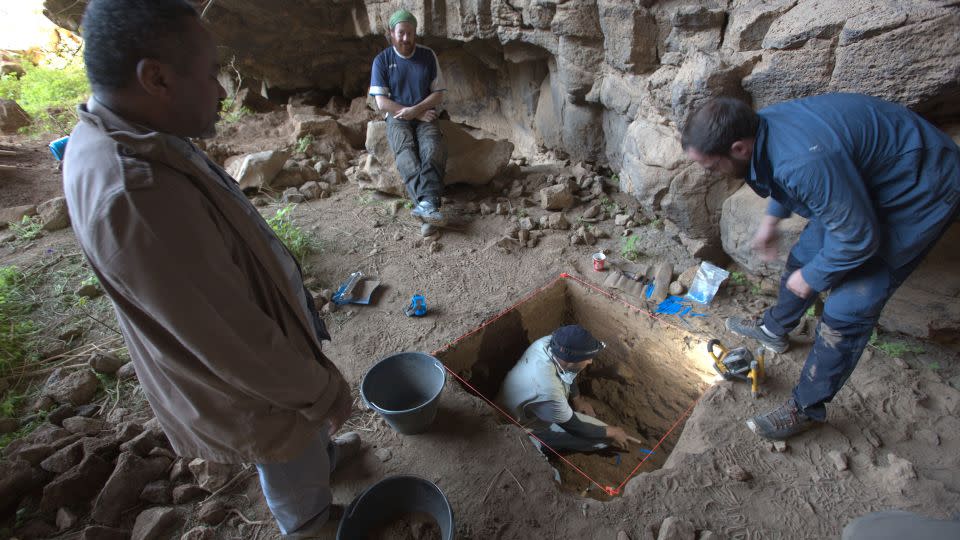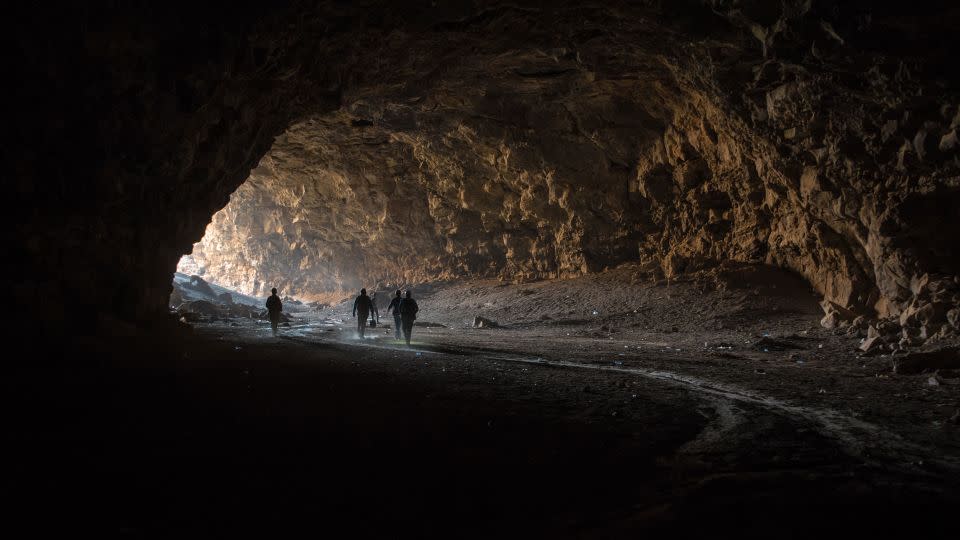Sign up for CNN’s Wonder Theory science newsletter. Explore the universe with news on exciting discoveries, scientific advances and more.
People who lived in the Arabian Peninsula thousands of years ago went underground trying to beat the heat. Perhaps stopping there as they traveled between fields and grasslands, they entered vast underground tunnels where molten lava had flowed millions of years earlier, according to a recent study.
Beginning in the Stone Age, Neolithic herders arrived and occupied these huge tunnels, known as lava tubes, discovered by archaeologists. Cooler air underground would provide relief from the sun and wind, and for thousands of years, people sheltered their livestock in the tunnels. The herders left behind objects and even carved pictures on the rocky walls, researchers reported April 17 in the journal PLOS One.
In the lava field of Harrat Khaybar, about 78 miles (125 kilometers) north of Medina in Saudi Arabia is a tunnel system known as Umm Jirsan, the longest in the region. Scientists have not yet confirmed the age of the lava that formed this system, but a 2007 study suggested it was around 3 million years old. Umm Jirsan spans nearly 1 mile (1.5 kilometers), with passages up to 39 feet (12 meters) high and as much as 148 feet (45 meters) wide.
Archaeologists at Umm Jirsan have recently discovered animal bones from 400 years to more than 4,000 years ago, and human remains from 150 years to about 6,000 years ago. The research team also found fragments of cloth, pieces of carved wood and dozens of stone tools – the first evidence of human use of the tunnels, starting at least 7,000 years ago.
“From earlier reports we knew that fossils were preserved at the site,” said lead study author Dr. Mathew Stewart, research fellow at the Australian Research Center for Human Evolution at Griffith University in Australia.
“However, we did not expect to find evidence of human occupation in the form of rock art, lithic artifacts, stone structures, and pottery,” Stewart told CNN in an email. “People have used and occupied these lava tubes over thousands of years. While most of the research in Arabia has focused on surface sites, underground sites like Umm Jirsan have great potential to fill some of the data gaps.”
This discovery highlights the importance of Umm Jirsan and other tunnels for understanding human dispersal in the region, said Guillaume Charloux, an archaeologist with France’s National Center for Scientific Research. In general, knowledge about the ancient climate and people in northwestern Saudi Arabia is limited, “especially during the transition period between the Neolithic and the beginning of the 2nd millennium,” said Charloux, who studies ancient sites in Saudi Arabia but does not he had something to do with the new. research. .

Around this time, the locals were settling around recently formed youths; The appearance of these desert sanctuaries would shape human migration patterns in the region for thousands of years, he said by email. “It seems to me that the main contribution of this major innovative research project is that it brings to light the long-term use — probably short-lived occupation — of this understudied type of cave, and their enormous potential, to especially for understanding. paleoenvironmental contexts.”
‘Green Arabia’
For nearly 15 years, Stewart and his colleagues have been collecting evidence of ancient human life in Arabia, mainly from sites around lake deposits, Stewart said. Beginning about 400,000 years ago, recurring periods of moisture saturated the Arabian deserts with rain. During these “Green Arabia” phases, lakes and ponds proliferated and the landscape became lush with vegetation, leading to waves of human migration that spread into southwest Asia, Stewart and other researchers reported. previously in the journal Nature.
But the last stage in Green Arabia was about 55,000 years ago, and intensively grown environments are not kind to archaeological evidence. While stone tools preserve well in dry deserts, bones and other organic materials are easily degraded and destroyed by erosion and extremes of heat and cold, leaving researchers with little to understand, Stewart said.
“To that end, in 2019 we decided to investigate underground sites where organics and sediments could be better preserved,” he said.
So the scientists turned their attention to Umm Jirsan. The site was previously mapped by the Saudi Geological Survey, and a 2009 report described it as a haven for wild animals such as foxes, wolves, birds and snakes. Among the hoards of bones in the tunnels were fragments of human skulls believed to be around 4,000 years old at the time. But until 2019, the tunnel system had not yet been investigated by archaeologists, Stewart said.


“We were able to date the animal bones and sediment, which tells us that humans began to inhabit the cave 7,000 years ago and possibly as early as 10,000 years ago,” Stewart said.
Compared to other inhabited sites, the amount of archaeological material at Umm Jirsan is “rare,” suggesting that people visited the tunnels as a temporary shelter rather than a permanent resident. , the study authors reported.
Animal carving
In another tunnel near Umm Jirsan, the researchers found 16 panels of carved rock art. The carvings appeared to be pastoral scenes, with people with tools, people with maidens standing alongside domesticated animals such as dogs, cattle, goats and sheep. Other carvings showed animals with large arched horns like those of an ibex; however, these horned animals may represent another breed of domesticated goat, according to the study. The subjects of the carvings and their varnish coating suggest that they belong to a regional period known as the Chalcolithic (around 4500 to 3500 BC), which preceded the rise of the Bronze Age.
“Together, the archaeological findings of the site and the surrounding landscape paint a picture of the recurring use of the Umm Jirsan Lava Tube over thousands of years,” said Stewart. The site — located along a well-known migration route for Bronze Age herders — “could be a stopping point, a place of refuge protected from the elements.”
This unprecedented evidence of human occupation in the ancient lava tubes of Arabia sheds light on how humans adapted to live in arid landscapes, and further investigation of Umm Jirsan and other lava tubes promises to add more details, which Stewart said.
“These sites have great potential to fill some of the gaps in the natural and cultural archive that survive in the archaeological record of Arabia.”
Mindy Weisberger is a science writer and media producer whose work has appeared in Live Science, Scientific American and How It Works magazine.
For more CNN news and newsletters create an account at CNN.com